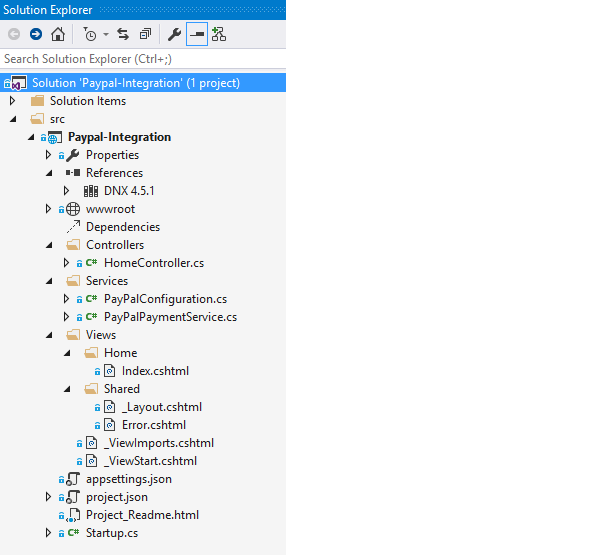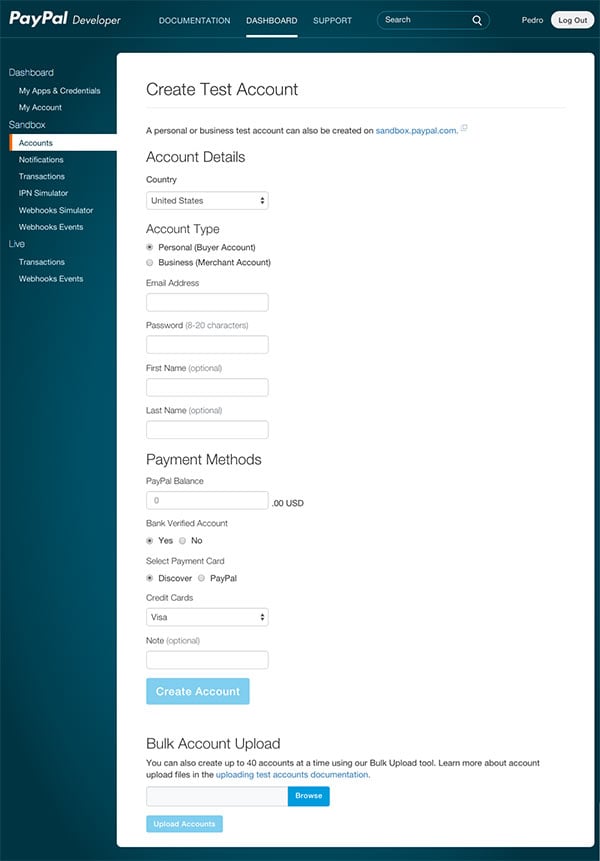
在本教程中,我将向您展示如何使用 PayPal REST API 和 C# 进行付款。他们针对 Ruby、Node.js、Python、PHP 等不同语言提供的所有库都非常相似,因此这里的所有概念都适用于所有库。
首先,我在 Visual Studio 2015 中创建了一个 MVC 项目:文件 > 新建 > 项目,然后选择 ASP.NET 应用程序。

选择 ASP.NET 5 Web 应用程序 模板,该模板使用新的 MVC 6。如果您熟悉的话,它与 MVC 5 类似。

正如您在下面的照片中看到的,我已向解决方案添加了一些文件和文件夹。主要需要注意的两件事是:

使用 NuGet 安装 PayPal SDK。 右键点击解决方案名称并选择管理 NuGet 包,然后搜索“PayPal”并安装它。

要将我们的应用程序与 PayPal 集成,我们需要导航到 PayPal Developers,然后在 REST API 应用程序下,点击创建应用程序。

为您的应用命名并选择与该应用关联的沙盒开发者帐户。出于测试目的,我们可以导航到 http://sandbox.paypal.com 并使用沙箱登录详细信息进行登录,以查看测试 PayPal 帐户和交易。

点击创建应用程序后,我们会看到包含客户端 ID 和秘密令牌的确认屏幕.

将 clientId 和 clientSecret 令牌复制到 appsettings.json,如屏幕截图中所示如下:

PayPal 提供了沙盒环境进行测试。您可以从那里创建测试买家和卖家帐户。注册后,您将在沙盒中拥有一个与您的开发者帐户绑定的企业帐户。
要创建新的测试帐户,请登录开发者网站,然后点击控制面板标签并导航至沙盒 > 帐户。 您可以在此处查看测试帐户列表(如果有):

如果您尚未创建测试帐户,请继续并点击创建帐户在右上角,创建至少一个测试个人帐户和一个测试企业帐户。

创建测试帐户后,您可以使用测试电子邮件地址和密码通过 www.sandbox.paypal.com 登录您在上一个表格上分配给每个帐户的信息。这对于测试当您使用“个人测试帐户”购买商品时资金是否会转移到您的“测试企业帐户”非常有用。现在您已准备好开始与 PayPal 集成并测试资金是否从一个帐户转移到另一个帐户。
PayPal 提供不同的付款方式。您可以使用直接信用卡付款,这意味着您的客户无法看到 PayPal 登录页面或摘要 - 这一切都发生在您的网站上。为此,您需要符合 PCI 标准,我建议使用 Stripe,因为您只需要使用其 JavaScript 库的 SSL。另一方面,要通过 PayPal 付款,需要三个步骤:
在我的 MVC 项目的 Services 文件夹中,我创建了 PayPalPaymentService 类,并在其中添加了以下方法:
public static Payment CreatePayment(string baseUrl, string intent)
{
// ### Api Context
// Pass in a `APIContext` object to authenticate
// the call and to send a unique request id
// (that ensures idempotency). The SDK generates
// a request id if you do not pass one explicitly.
var apiContext = PayPalConfiguration.GetAPIContext();
// Payment Resource
var payment = new Payment()
{
intent = intent, // `sale` or `authorize`
payer = new Payer() { payment_method = "paypal" },
transactions = GetTransactionsList(),
redirect_urls = GetReturnUrls(baseUrl, intent)
};
// Create a payment using a valid APIContext
var createdPayment = payment.Create(apiContext);
return createdPayment;
}
private static List<Transaction> GetTransactionsList()
{
// A transaction defines the contract of a payment
// what is the payment for and who is fulfilling it.
var transactionList = new List<Transaction>();
// The Payment creation API requires a list of Transaction;
// add the created Transaction to a List
transactionList.Add(new Transaction()
{
description = "Transaction description.",
invoice_number = GetRandomInvoiceNumber(),
amount = new Amount()
{
currency = "USD",
total = "100.00", // Total must be equal to sum of shipping, tax and subtotal.
details = new Details() // Details: Let's you specify details of a payment amount.
{
tax = "15",
shipping = "10",
subtotal = "75"
}
},
item_list = new ItemList()
{
items = new List<Item>()
{
new Item()
{
name = "Item Name",
currency = "USD",
price = "15",
quantity = "5",
sku = "sku"
}
}
}
});
return transactionList;
}
private static RedirectUrls GetReturnUrls(string baseUrl, string intent)
{
var returnUrl = intent == "sale" ? "/Home/PaymentSuccessful" : "/Home/AuthorizeSuccessful";
// Redirect URLS
// These URLs will determine how the user is redirected from PayPal
// once they have either approved or canceled the payment.
return new RedirectUrls()
{
cancel_url = baseUrl + "/Home/PaymentCancelled",
return_url = baseUrl + returnUrl
};
}
public static Payment ExecutePayment(string paymentId, string payerId)
{
// ### Api Context
// Pass in a `APIContext` object to authenticate
// the call and to send a unique request id
// (that ensures idempotency). The SDK generates
// a request id if you do not pass one explicitly.
var apiContext = PayPalConfiguration.GetAPIContext();
var paymentExecution = new PaymentExecution() { payer_id = payerId };
var payment = new Payment() { id = paymentId };
// Execute the payment.
var executedPayment = payment.Execute(apiContext, paymentExecution);
return executedPayment;
}
此调用中传递了一些参数:
可以从控制器中使用以前的功能,如下所示:
public IActionResult CreatePayment()
{
var payment = PayPalPaymentService.CreatePayment(GetBaseUrl(), "sale");
return Redirect(payment.GetApprovalUrl());
}
public IActionResult PaymentCancelled()
{
// TODO: Handle cancelled payment
return RedirectToAction("Error");
}
public IActionResult PaymentSuccessful(string paymentId, string token, string PayerID)
{
// Execute Payment
var payment = PayPalPaymentService.ExecutePayment(paymentId, PayerID);
return View();
}
如您所见,我创建了三个操作:
此场景与前一个案例非常相似。如果您尝试预订尚未上市的产品,您可能需要使用此方法。获得这笔付款的步骤是:
为了实现这种类型的付款,我只在 PayPalPaymentService 类中添加了一个新方法来捕获付款:
public static Capture CapturePayment(string paymentId)
{
var apiContext = PayPalConfiguration.GetAPIContext();
var payment = Payment.Get(apiContext, paymentId);
var auth = payment.transactions[0].related_resources[0].authorization;
// Specify an amount to capture. By setting 'is_final_capture' to true, all remaining funds held by the authorization will be released from the funding instrument.
var capture = new Capture()
{
amount = new Amount()
{
currency = "USD",
total = "4.54"
},
is_final_capture = true
};
// Capture an authorized payment by POSTing to
// URI v1/payments/authorization/{authorization_id}/capture
var responseCapture = auth.Capture(apiContext, capture);
return responseCapture;
}
然后,我在 HomeController 中添加了两个新操作来显示此类付款:
public IActionResult AuthorizePayment()
{
var payment = PayPalPaymentService.CreatePayment(GetBaseUrl(), "authorize");
return Redirect(payment.GetApprovalUrl());
}
public IActionResult AuthorizeSuccessful(string paymentId, string token, string PayerID)
{
// Capture Payment
var capture = PayPalPaymentService.CapturePayment(paymentId);
return View();
}
在这些代码示例中,为了简单起见,我对付款变量值进行了硬编码。在您的实际应用程序中,您可能会将它们包装在将所有这些值作为变量的方法中,以便可以动态设置和重用所有内容。
这在 PayPal 中称为“结算计划” - 您可以创建定期付款计划,并通过创建结算协议为您的客户订阅结算计划。使用 PayPal REST API,您可以创建、更新或删除结算计划;如果您想构建一个管理面板来管理您的企业的这些事情,您可能会使用这个东西。
向客户创建经常性费用的步骤如下:
创建定义计费周期的计费计划。这是我们创建计划时需要传递的参数的摘要。
这是一个代码片段,展示了如何创建计费计划:
// Define the plan and attach the payment definitions and merchant preferences.
// More Information: https://developer.paypal.com/webapps/developer/docs/api/#create-a-plan
var billingPlan = new Plan
{
name = "Tuts+ Plus",
description = "Monthly plan for courses.",
type = "fixed",
// Define the merchant preferences.
// More Information: https://developer.paypal.com/webapps/developer/docs/api/#merchantpreferences-object
merchant_preferences = new MerchantPreferences()
{
setup_fee = GetCurrency("0"), // $0
return_url = "returnURL", // Retrieve from config
cancel_url = "cancelURL", // Retrieve from config
auto_bill_amount = "YES",
initial_fail_amount_action = "CONTINUE",
max_fail_attempts = "0"
},
payment_definitions = new List<PaymentDefinition>
{
// Define a trial plan that will only charge $9.99 for the first
// month. After that, the standard plan will take over for the
// remaining 11 months of the year.
new PaymentDefinition()
{
name = "Trial Plan",
type = "TRIAL",
frequency = "MONTH",
frequency_interval = "1",
amount = GetCurrency("0"), // Free for the 1st month
cycles = "1",
charge_models = new List<ChargeModel>
{
new ChargeModel()
{
type = "TAX",
amount = GetCurrency("1.65") // If we need to charge Tax
},
new ChargeModel()
{
type = "SHIPPING",
amount = GetCurrency("9.99") // If we need to charge for Shipping
}
}
},
// Define the standard payment plan. It will represent a monthly
// plan for $19.99 USD that charges once month for 11 months.
new PaymentDefinition
{
name = "Standard Plan",
type = "REGULAR",
frequency = "MONTH",
frequency_interval = "1",
amount = GetCurrency("15.00"),
// > NOTE: For `IFNINITE` type plans, `cycles` should be 0 for a `REGULAR` `PaymentDefinition` object.
cycles = "11",
charge_models = new List<ChargeModel>
{
new ChargeModel
{
type = "TAX",
amount = GetCurrency("2.47")
},
new ChargeModel()
{
type = "SHIPPING",
amount = GetCurrency("9.99")
}
}
}
}
};
// Get PayPal Config
var apiContext = PayPalConfiguration.GetAPIContext();
// Create Plan
plan.Create(apiContext);
新创建的结算计划处于 CREATED 状态。将其激活为“活动”状态,以便您的客户可以订阅该计划。要激活该计划,我们需要发出 PATCH 请求:
// Activate the plan
var patchRequest = new PatchRequest()
{
new Patch()
{
op = "replace",
path = "/",
value = new Plan() { state = "ACTIVE" }
}
};
plan.Update(apiContext, patchRequest);
如您所见,PayPal 库是其 REST API 的直接包装器,这很好,但与 Stripe 等其他 API 相比,该 API 也非常复杂。因此,将所有 PayPal 通信包装在对象中,为我们的应用程序提供更清晰、更简单的 API,这确实是一个不错的选择。在这里您可以看到封装在多个带有参数的函数中的代码的样子:
public static Plan CreatePlanObject(string planName, string planDescription, string returnUrl, string cancelUrl,
string frequency, int frequencyInterval, decimal planPrice,
decimal shippingAmount = 0, decimal taxPercentage = 0, bool trial = false, int trialLength = 0, decimal trialPrice = 0)
{
// Define the plan and attach the payment definitions and merchant preferences.
// More Information: https://developer.paypal.com/docs/rest/api/payments.billing-plans/
return new Plan
{
name = planName,
description = planDescription,
type = PlanType.Fixed,
// Define the merchant preferences.
// More Information: https://developer.paypal.com/webapps/developer/docs/api/#merchantpreferences-object
merchant_preferences = new MerchantPreferences()
{
setup_fee = GetCurrency("1"),
return_url = returnUrl,
cancel_url = cancelUrl,
auto_bill_amount = "YES",
initial_fail_amount_action = "CONTINUE",
max_fail_attempts = "0"
},
payment_definitions = GetPaymentDefinitions(trial, trialLength, trialPrice, frequency, frequencyInterval, planPrice, shippingAmount, taxPercentage)
};
}
private static List<PaymentDefinition> GetPaymentDefinitions(bool trial, int trialLength, decimal trialPrice,
string frequency, int frequencyInterval, decimal planPrice, decimal shippingAmount, decimal taxPercentage)
{
var paymentDefinitions = new List<PaymentDefinition>();
if (trial)
{
// Define a trial plan that will charge 'trialPrice' for 'trialLength'
// After that, the standard plan will take over.
paymentDefinitions.Add(
new PaymentDefinition()
{
name = "Trial",
type = "TRIAL",
frequency = frequency,
frequency_interval = frequencyInterval.ToString(),
amount = GetCurrency(trialPrice.ToString()),
cycles = trialLength.ToString(),
charge_models = GetChargeModels(trialPrice, shippingAmount, taxPercentage)
});
}
// Define the standard payment plan. It will represent a 'frequency' (monthly, etc)
// plan for 'planPrice' that charges 'planPrice' (once a month) for #cycles.
var regularPayment = new PaymentDefinition
{
name = "Standard Plan",
type = "REGULAR",
frequency = frequency,
frequency_interval = frequencyInterval.ToString(),
amount = GetCurrency(planPrice.ToString()),
// > NOTE: For `IFNINITE` type plans, `cycles` should be 0 for a `REGULAR` `PaymentDefinition` object.
cycles = "11",
charge_models = GetChargeModels(trialPrice, shippingAmount, taxPercentage)
};
paymentDefinitions.Add(regularPayment);
return paymentDefinitions;
}
private static List<ChargeModel> GetChargeModels(decimal planPrice, decimal shippingAmount, decimal taxPercentage)
{
// Create the Billing Plan
var chargeModels = new List<ChargeModel>();
if (shippingAmount > 0)
{
chargeModels.Add(new ChargeModel()
{
type = "SHIPPING",
amount = GetCurrency(shippingAmount.ToString())
});
}
if (taxPercentage > 0)
{
chargeModels.Add(new ChargeModel()
{
type = "TAX",
amount = GetCurrency(String.Format("{0:f2}", planPrice * taxPercentage / 100))
});
}
return chargeModels;
}
您可以通过提出“PATCH”请求来更新现有结算方案的信息。这是一个包装该调用的函数:
public static void UpdateBillingPlan(string planId, string path, object value)
{
// PayPal Authentication tokens
var apiContext = PayPalConfiguration.GetAPIContext();
// Retrieve Plan
var plan = Plan.Get(apiContext, planId);
// Activate the plan
var patchRequest = new PatchRequest()
{
new Patch()
{
op = "replace",
path = path,
value = value
}
};
plan.Update(apiContext, patchRequest);
}
要更新计费计划描述,我们可以调用此函数并传递正确的参数:
UpdateBillingPlan(
planId: "P-5FY40070P6526045UHFWUVEI",
path: "/",
value: new Plan { description = "new description" });
理想情况下,当您不想接受新客户加入结算计划时,您需要将其更新为“非活动”状态。这不会影响该计划的现有计费协议。只需调用 UpdateBillingPlan 函数即可完成此操作:
UpdateBillingPlan(
planId: "P-5FY40070P6526045UHFWUVEI",
path: "/",
value: new Plan { state = "INACTIVE" });
创建一个或多个结算计划后,您希望开始让客户注册您的订阅计划。为此,您需要收集客户详细信息并向 PayPal 提出请求。为了能够测试此功能,我向 HomeController 添加了几个操作:
public IActionResult Subscribe()
{
var plan = PayPalSubscriptionsService.CreateBillingPlan("Tuts+ Plan", "Test plan for this article", GetBaseUrl());
var subscription = PayPalSubscriptionsService.CreateBillingAgreement(plan.id,
new PayPal.Api.ShippingAddress
{
city = "London",
line1 = "line 1",
postal_code = "SW1A 1AA",
country_code = "GB"
}, "Pedro Alonso", "Tuts+", DateTime.Now);
return Redirect(subscription.GetApprovalUrl());
}
public IActionResult SubscribeSuccess(string token)
{
// Execute approved agreement
PayPalSubscriptionsService.ExecuteBillingAgreement(token);
return View();
}
public IActionResult SubscribeCancel(string token)
{
// TODO: Handle cancelled payment
return RedirectToAction("Error");
}
正如您在前面的代码片段中看到的,我已将大部分功能包装在几个方法中。第一个是上一节中解释的“CreateBillingPlan”。第二个是“CreateBillingAgreement”,用于为用户订阅计划:
public static Agreement CreateBillingAgreement(string planId, ShippingAddress shippingAddress,
string name, string description, DateTime startDate)
{
// PayPal Authentication tokens
var apiContext = PayPalConfiguration.GetAPIContext();
var agreement = new Agreement()
{
name = name,
description = description,
start_date = startDate.ToString("yyyy-MM-ddTHH:mm:ss") + "Z",
payer = new Payer() { payment_method = "paypal" },
plan = new Plan() { id = planId },
shipping_address = shippingAddress
};
var createdAgreement = agreement.Create(apiContext);
return createdAgreement;
}
第三种方法是“ExecuteBillingAgreement”。成功订阅批准后,我们使用返回的令牌来激活订阅:
public static void ExecuteBillingAgreement(string token)
{
// PayPal Authentication tokens
var apiContext = PayPalConfiguration.GetAPIContext();
var agreement = new Agreement() { token = token };
var executedAgreement = agreement.Execute(apiContext);
}
使用此方法暂停协议:
public static void SuspendBillingAgreement(string agreementId)
{
var apiContext = PayPalConfiguration.GetAPIContext();
var agreement = new Agreement() { id = agreementId };
agreement.Suspend(apiContext, new AgreementStateDescriptor()
{ note = "Suspending the agreement" });
}
这个与上一个非常相似:
public static void ReactivateBillingAgreement(string agreementId)
{
var apiContext = PayPalConfiguration.GetAPIContext();
var agreement = new Agreement() { id = agreementId };
agreement.ReActivate(apiContext, new AgreementStateDescriptor()
{ note = "Reactivating the agreement" });
}
使用此功能取消计划:
public static void CancelBillingAgreement(string agreementId)
{
var apiContext = PayPalConfiguration.GetAPIContext();
var agreement = new Agreement() { id = agreementId };
agreement.Cancel(apiContext, new AgreementStateDescriptor()
{ note = "Cancelling the agreement" });
}
这个选项非常有限,我希望从这次通话中可以更改订阅计划,以升级或降级客户。与 Stripe 不同,单次调用不支持此功能。您需要通过取消当前协议并创建新的升级或降级协议来处理这种情况。这并不理想,但将来可能会改变。
这是人们用来与 PayPal 集成的最常用功能的概述。他们的 API 比本文中解释的集成方法要大得多 - 您还可以发放退款和部分退款,并且他们针对本文涵盖的示例中的边缘情况提供了许多不同的选项。如果您有兴趣获得有关任何特定集成的更多详细信息,请在评论中留下建议。
以上是深入解析:PayPal整合第二部分:PayPal REST API的详细内容。更多信息请关注PHP中文网其他相关文章!




